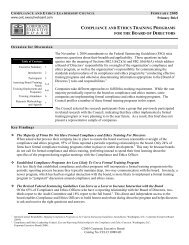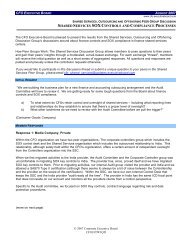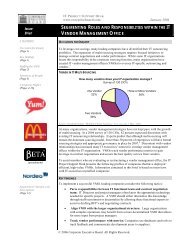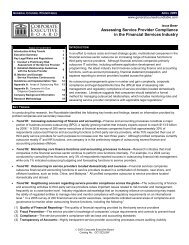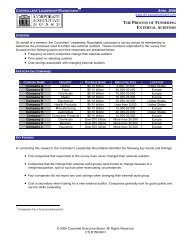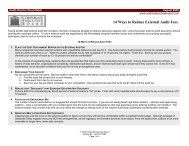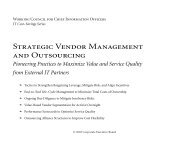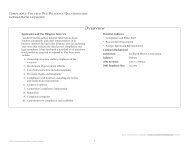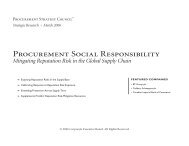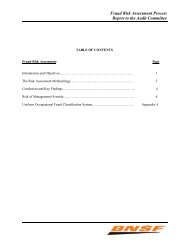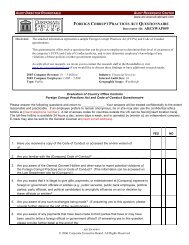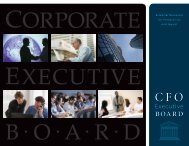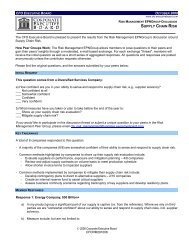Establishing Comprehensive Supplier Qualification Processes
Establishing Comprehensive Supplier Qualification Processes
Establishing Comprehensive Supplier Qualification Processes
Create successful ePaper yourself
Turn your PDF publications into a flip-book with our unique Google optimized e-Paper software.
PROCUREMENT STRATEGY COUNCIL TM JULY 2006<br />
www.psc.executiveboard.com<br />
KEY FINDINGS<br />
<strong>Establishing</strong> <strong>Comprehensive</strong> <strong>Supplier</strong> <strong>Qualification</strong> <strong>Processes</strong><br />
Related Council<br />
Research:<br />
BUILDING AGILE SUPPLIER<br />
QUALIFICATION PROCESSES<br />
(DECEMBER 2005)<br />
ENSURING SUPPLIER<br />
PRODUCTION QUALITY: KEY<br />
FINDINGS<br />
(JULY 2004)<br />
OPTIMIZING POLICIES AND<br />
PROCEDURES FOR ONSITE<br />
SUPPLIER AUDITS: INITIATIVE<br />
SNAPSHOT<br />
(FEBRUARY 2006)<br />
ISSUE OVERVIEW<br />
As organizations increasingly collaborate with fewer strategic suppliers, procurement<br />
organizations face the challenge of driving supplier improvement through<br />
quantifiable and clearly defined evaluation criteria. The supplier qualification<br />
process helps identify candidates for strategic relationships, facilitates<br />
communication with potential suppliers, and ensures new suppliers meet firm-wide<br />
quality, management, and safety standards.<br />
Leading companies recognize the importance of comprehensive supplier<br />
qualification processes but struggle to communicate qualification requirements to<br />
potential suppliers, create baselines for evaluating supplier risk levels, and ensure<br />
material conformance to specific requirements. Some procurement functions adopt<br />
recognized qualification standards to evaluate product quality during supplier<br />
qualification. International standards, such as ISO 9000 or TS-16949, promote broad<br />
participation and qualification of suppliers and create selection criteria for several<br />
processes including design control, inspections, equipment testing, handling, storing,<br />
packaging, and delivery.<br />
Recognized qualification standards such as ISO 9000 outline management processes<br />
and enable high-quality production, but may prove too general for industry<br />
specifications. As a result, companies often create supplementary criteria to ensure<br />
comprehensive supplier evaluations and applicability to specific industry needs. The<br />
table below outlines benefits and challenges procurement executives must consider<br />
prior to adopting standard or custom qualification criteria. 1<br />
CUSTOM VERSUS RECOGNIZED QUALIFICATION STANDARDS<br />
Aligning the qualification process with company needs<br />
BENEFITS<br />
CHALLENGES<br />
Based on specificity of<br />
the organization’s<br />
needs and available<br />
resources, companies<br />
can either adopt or<br />
develop qualification<br />
standards.<br />
S<br />
o<br />
u<br />
r<br />
c<br />
e<br />
:<br />
P<br />
r<br />
o<br />
I<br />
CUSTOMIZED<br />
CRITERIA<br />
STANDARD<br />
CRITERIA<br />
• Customizes supplier evaluations to<br />
meet organization’s needs<br />
• Focuses on industry-specific<br />
standards<br />
• Addresses each supplier’s<br />
respective development areas<br />
• Reduces need for preliminary<br />
qualifications and site visits<br />
• Provides an internationally<br />
recognized foundation for quality<br />
measurement<br />
• Requires extensive development<br />
time and capital commitment<br />
• Creates lack of uniformity across<br />
business units and results in<br />
supplier miscommunications<br />
• Costly process for suppliers<br />
• Does not guarantee continuous<br />
quality improvement<br />
• Quality standard too general for<br />
specific materials<br />
Source: Procurement Strategy Council Research (2003)<br />
© 2006 CORPORATE EXECUTIVE BOARD. ALL RIGHTS RESERVED.
PROCUREMENT STRATEGY COUNCIL PAGE 2<br />
ESTABLISHING COMPREHENSIVE SUPPLIER QUALIFICATION PROCESSES<br />
In addition to establishing appropriate selection criteria, procurement functions also<br />
need to maintain clear communication channels with potential suppliers at each stage<br />
of the qualification process. The function can choose from a variety of online tools,<br />
handbooks, or databases to establish expectations and requirements.<br />
<strong>Comprehensive</strong> supplier qualification processes and tools enable organizations to<br />
monitor supplier performance history and direct management attention to suppliers<br />
unable to meet qualification criteria. By establishing and measuring performance<br />
baselines, Procurement can save time and resources by disqualifying suppliers that<br />
do not meet required company standards.<br />
To assist members with challenges in implementing effective supplier qualification<br />
procedures, the Procurement Strategy Council presents the following findings.<br />
KEY FINDINGS<br />
Council research identified several strategies procurement organizations implement<br />
to ensure optimal and consistent supplier qualification standards, including the<br />
following:<br />
• Deploy electronic tools to manage qualification data: As companies<br />
increasingly shift sourcing strategies to encompass multiple markets,<br />
procurement functions should maintain supplier portals or automated data<br />
management systems to track qualification information for global suppliers.<br />
Global electronic databases increase transparency across procurement staff and<br />
business units. This visibility increases access to qualification requirements and<br />
audit results and encourages communication with suppliers to quickly resolve<br />
identified issues.<br />
Procurement at Cadbury Schweppes (profiled on pages 4-5) manages the<br />
qualification process for over 3,000 global suppliers through a supplier<br />
information database called FLAIR. The database automatically asks suppliers<br />
to provide additional or updated qualification information, including suppliers’<br />
commercial status, ethical sourcing standards, innovation strategies, and<br />
business models. A color coded “stoplight” system within FLAIR records audit<br />
results and enables the procurement function to determine need for additional<br />
onsite audits of supplier facilities.<br />
• Establish and measure supplier safety risk levels: To ensure potential<br />
suppliers meet firm-wide health and safety standards, procurement functions<br />
should require suppliers to supplement general qualification requirements with<br />
safety and insurance information. Some companies evaluate supplier risk based<br />
on Occupational Health & Safety Administration (OSHA) reportable accidents,<br />
while others require suppliers to complete detailed ethical assessments on<br />
policies and management practices.<br />
At Salt River Project (SRP) (profiled on pages 6-8), Procurement Services<br />
collaborates with Risk Management during the supplier qualification process to<br />
track supplier safety information, compile supplier risk profiles, and verify<br />
insurance coverage. Risk Management develops and maintains a set of safety<br />
criteria measured through a Contractor Safety Management Program (CSMP)<br />
questionnaire. Contractors and service providers must meet or exceed a<br />
minimum risk score recommended by Risk Management to conduct business<br />
with SRP.<br />
© 2006 CORPORATE EXECUTIVE BOARD. ALL RIGHTS RESERVED.
PROCUREMENT STRATEGY COUNCIL PAGE 3<br />
ESTABLISHING COMPREHENSIVE SUPPLIER QUALIFICATION PROCESSES<br />
• Verify product quality levels: In addition to general qualification criteria,<br />
procurement functions must ensure that direct material suppliers’ products<br />
conform to the firm’s quality standards and specification requirements. The<br />
function should review supplier sample materials and manufacturing capabilities<br />
through on-site assessments and product reliability tests. Procurement should<br />
use these assessments to inform supplier selection and as a benchmark for postcontract<br />
performance evaluations.<br />
Strategic Sourcing at ON Semiconductor (profiled on pages 9-11) mandates<br />
direct material suppliers to complete a quality system self-assessment, submit<br />
quality certificates, and provide product samples for reliability testing prior to<br />
final approval. By incorporating additional material verification steps during the<br />
supplier qualification process, the function ensures suppliers’ products meet<br />
quality and durability standards, as well as conform to required specifications.<br />
Additionally, Strategic Sourcing utilizes a Specification Automated Mailing<br />
System (SAMS) to update suppliers with applicable material specification<br />
revisions.<br />
© 2006 CORPORATE EXECUTIVE BOARD. ALL RIGHTS RESERVED.
PROCUREMENT STRATEGY COUNCIL PAGE 4<br />
ESTABLISHING COMPREHENSIVE SUPPLIER QUALIFICATION PROCESSES<br />
INITIATIVE PROFILE: CADBURY SCHWEPPES UTILIZES A GLOBAL ELECTRONIC DATABASE<br />
TO MANAGE QUALIFICATION REQUIREMENTS<br />
Company Capsule<br />
Industry: Food Manufacturing<br />
2005 Sales: Over $5 Billion<br />
2005 Employees: Over 50,000<br />
Cadbury Schweppes is a leading global confectioner and soft drink producer. Since<br />
the company increasingly sources from global suppliers, the procurement function<br />
must ensure new global suppliers’ compliance with the firm’s quality and ethical<br />
sourcing standards. To improve management of global supplier qualification<br />
information, the company created a supplier information database called FLAIR. The<br />
database tracks supplier qualification requirements and directs management attention<br />
to areas of concern.<br />
The graphic below outlines Cadbury Schweppes’ standard supplier selection process.<br />
CADBURY SCHWEPPES’ STANDARD SUPPLIER QUALIFICATION PROCESS<br />
Cadbury Schweppes leverages technology to manage new supplier qualification<br />
information<br />
The FLAIR database enables<br />
procurement to track supplier<br />
qualification information,<br />
record audit results, and<br />
monitor document expiration<br />
dates.<br />
Potential suppliers<br />
submit RFI and<br />
prequalification<br />
questionnaire<br />
Procurement inputs<br />
supplier<br />
qualification<br />
information and<br />
performance history<br />
into FLAIR<br />
FLAIR’s colorcoded<br />
“stoplights”<br />
record audit<br />
results<br />
!<br />
FLAIR<br />
automatically<br />
notifies category<br />
managers when<br />
supplier<br />
documentation<br />
nears expiration<br />
Procurement asks<br />
suppliers to<br />
provide updated<br />
qualification<br />
information<br />
Source: Cadbury Schweppes; Procurement Strategy Council Research (2006)<br />
FLAIR assists Procurement to manage qualification requirements during the full<br />
supplier qualification process, as outlined below:<br />
• Register new suppliers: During initial registration, Procurement enters<br />
suppliers’ background information into the FLAIR database.<br />
• Evaluate suppliers in a competitive market environment: Procurement<br />
requires potential suppliers to complete a Request for Information (RFI) and a<br />
supplier prequalification form (see Appendix A, page 12). The prequalification<br />
form includes detailed questions on the following four key selection criteria:<br />
The supplier prequalification<br />
form includes questions on<br />
financial information, ethical<br />
sourcing standards, research<br />
capability, and expected future<br />
growth.<br />
1. Financial qualification: Dunn & Bradstreet financial reports and insurance<br />
information.<br />
2. Ethical sourcing standards: Policies and performance related to<br />
environment, health, and safety standards.<br />
3. Research and development: Innovation capabilities, level of research<br />
commitment, and alignment on common future development goals.<br />
4. Business model: Expected growth in specific geographic areas.<br />
<strong>Supplier</strong>s must meet all prequalification requirements to conduct business with<br />
Cadbury Schweppes. By tracking qualification information within FLAIR,<br />
Procurement identifies missing information and encourages potential suppliers<br />
to conform to company standards.<br />
• Audit new suppliers: At Cadbury-Schweppes, the procurement function audits<br />
new suppliers across all spend categories during the supplier qualification<br />
process. The FLAIR database tracks audit results through a color-coded<br />
© 2006 CORPORATE EXECUTIVE BOARD. ALL RIGHTS RESERVED.
PROCUREMENT STRATEGY COUNCIL PAGE 5<br />
ESTABLISHING COMPREHENSIVE SUPPLIER QUALIFICATION PROCESSES<br />
Stoplights within FLAIR direct<br />
management attention to<br />
potential suppliers unable to<br />
meet qualification criteria.<br />
“stoplight” system. Red scores indicate suppliers do not meet qualification<br />
standards, yellow scores highlight key issues requiring resolution, and green<br />
scores identify suppliers audited and approved for work with the company.<br />
Additionally, the system enables procurement to effectively measure number of<br />
suppliers audited and approved for work in the previous six months.<br />
• Monitor supplier certifications: During the supplier qualification process,<br />
category managers maintain responsibility for communication with potential<br />
suppliers. To ensure compliance with enterprise-wide policies and procedures,<br />
these individuals meet with suppliers on a quarterly basis to assess selected key<br />
performance indicators (KPIs) on service quality and delivery. The FLAIR<br />
database automatically notifies category managers when supplier documentation<br />
nears expiration and requires renewal.<br />
The procurement function currently qualifies and manages over 3,000 global<br />
suppliers through the database.<br />
Procurement manages the<br />
qualification process for over<br />
3,000 global suppliers through<br />
the FLAIR database.<br />
By incorporating a supplier information database into the qualification process,<br />
Cadbury Schweppes’ procurement function monitors qualification requirements,<br />
increases transparency across the department on supplier performance history, and<br />
encourages communication with suppliers to quickly resolve identified issues.<br />
Additionally, procurement staff can create a single globally accessible entry within<br />
FLAIR to track qualification information and audit results for new suppliers<br />
providing goods or services in more than one region.<br />
Currently Procurement manually transfers supplier information from the FLAIR<br />
database into the company’s larger supplier management software enabled by<br />
Procuri. The software enables procurement staff to track previous communication<br />
with suppliers and utilize standard templates during the sourcing process. Cadbury<br />
Schweppes is developing an automated system to integrate supplier information from<br />
the FLAIR database to Procuri and plans to implement the new system by the end of<br />
2006.<br />
© 2006 CORPORATE EXECUTIVE BOARD. ALL RIGHTS RESERVED.
PROCUREMENT STRATEGY COUNCIL PAGE 6<br />
ESTABLISHING COMPREHENSIVE SUPPLIER QUALIFICATION PROCESSES<br />
INITIATIVE PROFILE: SRP’S PROCUREMENT FUNCTION COLLABORATES WITH RISK<br />
MANAGEMENT TO EVALUATE SUPPLIER RISK DURING QUALIFICATION<br />
Company Capsule<br />
Industry: Electric Utilities<br />
• 2005 Sales: Between $1-5 billion<br />
• 2005 Employees: Under 10,000<br />
Salt River Project (SRP) is one of the largest US government-owned utilities. The<br />
procurement function emphasizes supplier compliance with firm-wide health and<br />
safety standards since suppliers conduct a significant proportion of services on SRP<br />
property. Procurement Services maintains responsibility for evaluating and<br />
approving new suppliers and collaborates with Risk Management to establish and<br />
measure supplier risk levels.<br />
SRP enters all potential suppliers into an ERP system. Once suppliers demonstrate<br />
compliance to required health and safety standards, SRP integrates approved supplier<br />
information into a central repository called the <strong>Supplier</strong> Information Database<br />
(SIDS). Procurement Services and Risk Management employ the following steps to<br />
evaluate supplier risk during qualification:<br />
• Initial registration: As a first step in evaluating supplier risk, Procurement<br />
Services requires suppliers to submit a pre-qualification safety questionnaire in<br />
addition to general contact information, W-9 forms, and references. Once<br />
suppliers provide all registration information, Procurement Services enters the<br />
data into an ERP system. The checklist below outlines qualification information<br />
suppliers must submit during initial registration.<br />
SALT RIVER PROJECT’S INITIAL REGISTRATION REQUIREMENTS<br />
Procurement Services requires the following qualification information during initial<br />
registration<br />
<strong>Supplier</strong> Information Database (SIDS) questionnaire<br />
A brief questionnaire containing questions on general<br />
contact information, state licenses, financial information,<br />
and references.<br />
During initial registration,<br />
suppliers must submit prequalification<br />
questionnaires,<br />
copies of safety and insurance<br />
certificates, and financial<br />
information.<br />
Contractor Safety Management Program (CSMP)<br />
pre-qualification questionnaire<br />
SRP requires suppliers to complete a pre-qualification<br />
safety questionnaire for on-site work at SRP facilities,<br />
work locations, or other properties.<br />
OSHA 200 / 300 Log<br />
<strong>Supplier</strong>s must submit copies of current year<br />
Occupational Safety & Health Administration (OSHA)<br />
300 log sheets and OSHA 200/300 log sheets for<br />
previous three years<br />
Experience Modification Rating (EMR)<br />
<strong>Supplier</strong>s must submit copies of Experience<br />
Modification Ratings (EMRs) for current year and<br />
previous three years. EMRs must be certified by<br />
suppliers’ insurance carriers.<br />
W-9 form<br />
Request for taxpayer identification number and<br />
certificates.<br />
Source: Salt River Project; Procurement Strategy Council Research (2006)<br />
© 2006 CORPORATE EXECUTIVE BOARD. ALL RIGHTS RESERVED.
PROCUREMENT STRATEGY COUNCIL PAGE 7<br />
ESTABLISHING COMPREHENSIVE SUPPLIER QUALIFICATION PROCESSES<br />
• Safety and risk assessment: Risk Management supports Procurement Services<br />
to establish standard controls and evaluate supplier risk through the following<br />
procedures:<br />
Risk Management establishes<br />
safety standards, monitors<br />
supplier risk, and verifies<br />
vendor insurance information.<br />
1. Establish consistent safety standards: Risk Management develops and<br />
maintains a set of criteria to measure supplier risk through a Contractor<br />
Safety Management Program (CSMP) questionnaire (see Appendix B, page<br />
17). The questionnaire covers topics including historical safety incidents,<br />
Occupational Safety & Health Administration (OSHA) recordable<br />
incidents, and internal safety and health training programs. Potential<br />
suppliers must meet or exceed a minimum standard recommended by Risk<br />
Management. The minimum standard is based on supplier size and level of<br />
risk relevant to services rendered. Senior management may override the<br />
qualification criteria for unique situations.<br />
2. Monitor supplier risk: Risk Management enters supplier responses to the<br />
CSMP questionnaire into a central database called the Risk Management<br />
Information System (RMIS). Based on performance on the CSMP scale,<br />
Risk Management compiles a risk profile for potential suppliers. Safety<br />
scores are valid for a period of three years. The database enables effective<br />
tracking of risk scores to ensure suppliers update safety information prior to<br />
expiration.<br />
Procurement Services<br />
disqualifies suppliers that do<br />
not meet required insurance<br />
coverage.<br />
3. Verify insurance coverage: SRP requires the following insurance coverage<br />
for any supplier or contractor performing services on SRP facilities,<br />
properties, or job sites:<br />
• Worker’s Compensation: Statutory<br />
• Commercial General Liability: $2 million<br />
• Commercial Auto Liability: $2 million<br />
• Architect and Engineering Liability: $1 million<br />
Risk Management gathers supplier insurance certification and stores<br />
information in the RMIS database for future reference. The department<br />
monitors expiration dates and sends letters to suppliers when certificates<br />
near expiration. After two failed attempts, Risk Management notifies<br />
Procurement Services to obtain certification directly from suppliers.<br />
• Registration verification: Once Risk Management completes supplier risk<br />
assessments, Procurement Services performs the following additional<br />
qualification checks on new suppliers:<br />
Procurement Services reviews<br />
supplier registration<br />
information, checks<br />
government watch-lists, and<br />
verifies state certificates.<br />
1. Verify supplier stability: Procurement Services reviews Dunn & Bradstreet<br />
reports, calls references, and analyzes suppliers’ risk profiles compiled by<br />
Risk Management. In some cases, Procurement Services contacts references<br />
for further verification.<br />
2. Review government watchlists: Procurement Services checks suppliers<br />
against the Office of Foreign Assets Control’s list of Specially Designated<br />
Nationals and Blocked Persons and the Department of State’s Foreign<br />
Terrorist Organizations.<br />
3. Validate state certification: Procurement Services verifies state certification<br />
for all contractors before final approval.<br />
© 2006 CORPORATE EXECUTIVE BOARD. ALL RIGHTS RESERVED.
PROCUREMENT STRATEGY COUNCIL PAGE 8<br />
ESTABLISHING COMPREHENSIVE SUPPLIER QUALIFICATION PROCESSES<br />
Procurement Services<br />
maintains a <strong>Supplier</strong><br />
Information Database to track<br />
supplier qualification<br />
information and past<br />
performance.<br />
• Data integration: Procurement Services next integrates vendor data from the<br />
ERP and RMIS systems into a single application called the <strong>Supplier</strong> Information<br />
Database (SIDS). The SIDS system tracks product and service information,<br />
work history, and safety records for all approved suppliers. To remain in the<br />
database, suppliers must resubmit registration information every two years.<br />
Additionally, the system enables internal business units to identify suppliers<br />
based on internal commodity codes, enter comments, and track supplier<br />
performance and historical issues.<br />
The following graphic outlines ownership over different activities during SRP’s<br />
extensive supplier qualification process.<br />
SALT RIVER PROJECT’S SUPPLIER QUALIFICATION PROCESS<br />
Procurement Services and Risk Management functions at SRP collaborate to evaluate<br />
supplier risk<br />
Procurement Services and Risk<br />
Managements collaborate to<br />
track supplier safety<br />
information, compile supplier<br />
risk profiles, and verify<br />
insurance coverage during the<br />
second qualification stage.<br />
Initial<br />
Registration<br />
Safety and Risk<br />
Assessment<br />
Registration<br />
Verification<br />
Procurement Services:<br />
• Send qualification requirements to potential suppliers<br />
• Enter potential supplier information into ERP system<br />
<strong>Supplier</strong>:<br />
• Submit pre-qualification questionnaires, safety certifications, financial<br />
information, and references<br />
• Complete Contractor Safety Management Program (CSMP) questionnaire<br />
Risk Management:<br />
• Enter supplier responses to CSMP questionnaire into Risk Management<br />
Information System (RMIS)<br />
• Verify and track supplier insurance coverage through RMIS<br />
• Compile supplier risk profiles<br />
Procurement Services:<br />
• Review Dunn & Bradstreet reports, call references, and analyze supplier<br />
risk profiles<br />
• Check suppliers against government watch-lists<br />
• Verify state license information<br />
Data<br />
Integration<br />
Procurement Services:<br />
• Integrate approved supplier information from ERP and RMIS systems<br />
into <strong>Supplier</strong> Information Database (SIDS)<br />
Source: Salt River Project; Procurement Strategy Council Research (2006)<br />
The CSMP questionnaire provides Procurement Services with a consistent set of<br />
criteria to evaluate suppliers’ safety policies and programs. By collaborating with<br />
Risk Management early in the process to establish and measure supplier risk levels,<br />
Procurement Services continues to save time and resources by disqualifying<br />
suppliers that do not meet firm-wide health and safety standards. Additionally, the<br />
SIDS database enables Procurement Services staff to track number of suppliers<br />
approved during qualification in a given time period.<br />
© 2006 CORPORATE EXECUTIVE BOARD. ALL RIGHTS RESERVED.
PROCUREMENT STRATEGY COUNCIL PAGE 9<br />
ESTABLISHING COMPREHENSIVE SUPPLIER QUALIFICATION PROCESSES<br />
INITIATIVE PROFILE: ON SEMICONDUCTOR ASSESSES QUALITY SYSTEMS TO QUALIFY ALL<br />
DIRECT MATERIAL SUPPLIERS<br />
Company Capsule<br />
Industry: Electronics<br />
2005 Sales: $1-5 Billion<br />
2005 Employees: 10,000-50,000<br />
ON Semiconductor is a leading manufacturer of power components and electrical<br />
appliances. Given the critical role direct goods play in production and operations,<br />
Strategic Sourcing incorporates additional quality verification steps during the<br />
supplier qualification process to ensure conformance to material specifications.<br />
Strategic Sourcing teams and supplier quality engineers collaborate to establish,<br />
communicate, and verify product quality requirements to potential suppliers.<br />
When the current supply base cannot meet direct material demands, a Strategic<br />
Sourcing manager evaluates new suppliers based on several qualification criteria,<br />
including financial stability, physical and technical capability, cost-competitiveness,<br />
and timeliness of delivery.<br />
The following flowchart outlines the process for qualifying and selecting direct<br />
suppliers at ON Semiconductor.<br />
ON SEMICONDUCTOR’S SUPPLIER QUALIFICATION PROCESS<br />
Strategic Sourcing inspects quality of suppliers’ product samples during the qualification<br />
process<br />
Requirement for direct<br />
material identified<br />
(Strategic Sourcing Team)<br />
Review current supply base<br />
(Strategic Sourcing Team)<br />
Select potential suppliers<br />
using qualification criteria<br />
(Strategic Sourcing Team)<br />
No<br />
Any acceptable<br />
from existing<br />
supply base<br />
Yes<br />
RFQ potential suppliers<br />
(Sourcing Manager)<br />
RFQ top suppliers<br />
(Sourcing Manager)<br />
New Quote<br />
Other <strong>Supplier</strong><br />
During qualification, strategic<br />
sourcing mandates suppliers<br />
to complete a quality system<br />
self assessment, submit quality<br />
certificates, and provide<br />
product samples for<br />
evaluation.<br />
Request Quality System self<br />
assessment & copy of<br />
certificate<br />
(<strong>Supplier</strong>/Quality Engineers)<br />
Select best candidate(s)<br />
based on: RFQ, SA, and<br />
criteria<br />
(Strategic Sourcing Team)<br />
Pricing<br />
acceptable<br />
Yes<br />
Ask supplier to submit<br />
material samples<br />
(Sourcing Manager)<br />
No<br />
Request new<br />
quote(s) or<br />
consider other<br />
suppliers<br />
Perform on site quality<br />
assessment<br />
(<strong>Supplier</strong>/Quality Engineers)<br />
Inspect supplier products and process<br />
capabilities<br />
(Quality Engineers)<br />
No<br />
Recommend<br />
to<br />
proceed<br />
Yes<br />
No<br />
Parts pass<br />
qualification<br />
Yes<br />
Proceed with production<br />
order<br />
(Sourcing Manager)<br />
Source: ON Semiconductor; Procurement Strategy Council Research (2006)<br />
© 2006 CORPORATE EXECUTIVE BOARD. ALL RIGHTS RESERVED.
PROCUREMENT STRATEGY COUNCIL PAGE 10<br />
ESTABLISHING COMPREHENSIVE SUPPLIER QUALIFICATION PROCESSES<br />
The table below summarizes general qualification criteria Strategic Sourcing uses to<br />
evaluate potential suppliers during the supplier qualification process outlined on the<br />
previous page.<br />
ON SEMICONDUCTOR’S SUPPLIER QUALIFICATION CRITERIA<br />
Strategic Sourcing evaluates direct material suppliers on five qualification criteria<br />
ON Semiconductor evaluates<br />
suppliers based on five<br />
standardized qualification<br />
criteria<br />
Competitive Advantage<br />
Demonstrate potential competitive advantage on<br />
factors including cost, service, and technology<br />
Quality Systems<br />
Adopt recognized quality standards such as TS-<br />
16949<br />
Service Levels<br />
Support and participate in ON Semiconductor’s<br />
key programs and initiatives<br />
Critical Products<br />
Either offer products or services critical to the<br />
firm’s operations or unavailable through existing<br />
suppliers<br />
Demand Management Capability<br />
Maintain financial resources and infrastructure<br />
to support current and future demands.<br />
Source: ON Semiconductor; Procurement Strategy Council Research (2006)<br />
In addition to general qualification criteria, ON Semiconductor requires suppliers to<br />
adopt recognized industry-standard quality systems such as TS-16949.<br />
ON Semiconductor’s Strategic Sourcing team implements the following practices to<br />
ensure potential suppliers meet product quality requirements:<br />
Strategic Sourcing examines<br />
new direct suppliers’ quality<br />
standards through selfassessments<br />
and product<br />
inspections.<br />
• Communicate product quality requirements: Strategic Sourcing directs<br />
suppliers to an online supplier handbook that outlines the company’s<br />
supplier quality requirements. The handbook ensures suppliers comply with<br />
the company’s product quality standards both before and after contract<br />
signing. Additionally, supplier quality engineers inform individual suppliers<br />
of sample and data requirements and provide notification of final approval.<br />
• Collect and review supplier self-assessments: Strategic Sourcing requires<br />
all potential suppliers complete a quality system self-assessment based on<br />
the TS-16949 system and provide copies of quality certificates. Any issues<br />
identified are corrected prior to final supplier approval.<br />
• Confirm sample products’ quality levels: Prior to the first shipment,<br />
Strategic Sourcing implements the product verification procedure to ensure<br />
material conformation to specifications. To enable high supplier quality, the<br />
function reviews supplier sample materials and manufacturing capabilities<br />
through three steps:<br />
1. Conformance to specifications: To ensure new suppliers can<br />
manufacture products to company specifications, Strategic<br />
Sourcing requires suppliers submit product samples for inspection.<br />
© 2006 CORPORATE EXECUTIVE BOARD. ALL RIGHTS RESERVED.
PROCUREMENT STRATEGY COUNCIL PAGE 11<br />
ESTABLISHING COMPREHENSIVE SUPPLIER QUALIFICATION PROCESSES<br />
The function verifies material conformance to electrical, chemical,<br />
structural, and mechanical requirements.<br />
ON Semiconductor conducts<br />
on-site quality assessments of<br />
all new suppliers.<br />
ON Semiconductor performs<br />
several reliability assessments<br />
to ensure supplier products are<br />
durable.<br />
2. Process capability: Strategic Sourcing conducts on-site quality<br />
assessments of all new suppliers as a systematic examination of<br />
manufacturing, packaging, and shipment processes.<br />
3. Product reliability: The Quality Department performs liability<br />
tests to ensure supplier materials conform to required<br />
specifications and meet process and product requirements. These<br />
tests include accelerated life and application testing.<br />
Once supplier product samples and manufacturing capabilities are inspected,<br />
Strategic Sourcing inputs all approved supplier information into a central repository<br />
called the Strategic Sourcing List. The repository enables Strategic Sourcing to<br />
identify approved suppliers for new sourcing opportunities and reduce the need to<br />
allocate resources to qualify additional suppliers.<br />
In addition to evaluating suppliers on consistent and objective qualification criteria,<br />
Strategic Sourcing inspects supplier product samples, performs on-site quality<br />
assessments, and tests product reliability. By incorporating material verification steps<br />
during the qualification process, Strategic Sourcing ensures new suppliers’ products<br />
conform to specification requirements.<br />
© 2006 CORPORATE EXECUTIVE BOARD. ALL RIGHTS RESERVED.
PROCUREMENT STRATEGY COUNCIL PAGE 12<br />
ESTABLISHING COMPREHENSIVE SUPPLIER QUALIFICATION PROCESSES<br />
APPENDIX A: CADBURY SCHWEPPES’ SUPPLIER PREQUALIFICATION QUESTIONNAIRE<br />
Cadbury Schweppes has established a Vendor Approval Process for all new suppliers that uses the following detailed set of questions<br />
as part of the selection procedure. The prequalification questionnaire provides basic information on operations of the company and<br />
approach to issues of concern. <strong>Supplier</strong>s must meet minimum standards to conduct business with Cadbury Schweppes. 2<br />
1. MANAGEMENT & CONTACT INFORMATION<br />
1.1 Please provide details of your company<br />
Scoring<br />
Company Name<br />
Street Address<br />
Town<br />
County<br />
Post Code<br />
Country<br />
Web Site<br />
Company Details<br />
1.2 Please provide details of your primary contact<br />
Name<br />
Title<br />
Phone<br />
Fax<br />
Email<br />
Mobile/Cell Phone<br />
Primary Contact<br />
1.3<br />
If you are completing on behalf of a subsidiary company, provide your parent company details below.<br />
Parent Company Name<br />
Street Address<br />
Town<br />
County<br />
Post Code<br />
Country<br />
Web Site<br />
Parent Company Details<br />
2. PREREQUISITES<br />
2.1 Do you accept that any subsequent agreement could be based on the [company] "Standard Terms & Conditions"<br />
Yes 1<br />
Scoring<br />
2.2 Do you accept the [company] "Confidentiality/Non Disclosure Agreement"<br />
Yes 1<br />
2.3 Do you accept the "Operational Conditions of Supply" to [company]<br />
Yes 1<br />
2.4 Do you agree to work towards the [company] "Ethical Sourcing Standard"<br />
Yes 1<br />
0<br />
© 2006 CORPORATE EXECUTIVE BOARD. ALL RIGHTS RESERVED.
PROCUREMENT STRATEGY COUNCIL PAGE 13<br />
ESTABLISHING COMPREHENSIVE SUPPLIER QUALIFICATION PROCESSES<br />
3. OPERATIONS - Delivery, Quality, Location<br />
3.1 Do you measure your delivery performance to your customers Yes 1<br />
Scoring<br />
3.2 As part of a formal programme do you document reasons for delivery failures and have action plans in place to prevent underlying<br />
Yes 1<br />
problems from recurring<br />
3.3 Do you have a documented policy/procedure that states that you will notify customers in advance if their requested delivery dates will be<br />
Yes 1<br />
missed<br />
3.4<br />
Please indicate which third-party certification/audit approval you have or are committed to achieving within 18 months<br />
from these [company]-approved programmes<br />
BRC Global Standard -- Food A Grade<br />
BRC Global Standard -- Food B Grade<br />
AIB Standard--Superior Rating<br />
AIB Standard--Excellence Rating<br />
IFS Standard--Higher Level<br />
BRC/IoP Global Standard--Food Packaging 1B (food contact material)<br />
AIB Food Contact Packaging Standard--Superior Rating<br />
AIB Food Contact Packaging Standard--Excellence<br />
Other<br />
3.5 If other or several, please specify below (ISO9001:2000 by itself is not sufficient):<br />
3.6<br />
To which recognized quality management systems are your operations certified<br />
ISO9000-2000<br />
Any others (please specify below)<br />
None<br />
3.7 If other, please specify below:<br />
3.8 Do you operate a documented quality-management system which covers the manufacture and supply of the product/service under consideration<br />
1<br />
Yes<br />
3.9 Do you comply with the food regulations applicable in both the country of origin/production and the country of sale<br />
Yes 1<br />
3.1 Do you have a formal and current business continuity/disaster recovery plan(s) in place that are available on request Note: These plans should<br />
Yes 1<br />
address both recovery of production capacity, product recall / withdrawal, and continuity of service.<br />
3.11 Does your organization maintain an active and formal Incident Management Team to deal with product integrity issues<br />
Yes 1<br />
3.12 Have you ever been involved in a voluntary withdrawal or mandatory recall regarding the materials to be supplied to [company]<br />
Yes 1<br />
3.13 If Yes, provide details and current status of event(s)<br />
3.14 Do you have the ability to specify which location produces supplies for [company] requirements Yes 1<br />
3.15 Can you demonstrate traceability of the raw materials used to produce products by batch or lot back to your supplier<br />
Yes 1<br />
3.16 Can you demonstrate traceability of products produced by batch or lot forward to your customer <br />
Yes 1<br />
3.17 Do you have someone responsible for quality in your organization<br />
3.18 Please provide his/her name, title, and function below:<br />
© 2006 CORPORATE EXECUTIVE BOARD. ALL RIGHTS RESERVED.
PROCUREMENT STRATEGY COUNCIL PAGE 14<br />
ESTABLISHING COMPREHENSIVE SUPPLIER QUALIFICATION PROCESSES<br />
4. FINANCIAL/INSURANCE/LEGAL INFORMATION<br />
4.1 Please provide your Dun & Bradstreet number (if known)<br />
Scoring<br />
4.2 Please provide your Dun & Bradstreet ratings (if known) D&B rating<br />
D&B failure score<br />
4.3 Please provide the the following financial information for the last three financial years<br />
£ Sterling £ Sterling £ Sterling<br />
Turnover<br />
Pre-Tax Profit<br />
Current Assets<br />
Current Liabilities<br />
Please State Year<br />
Please State Base Currency Used<br />
Please State Exchange Rates Used<br />
(Please attach your last 3 years financial accounts)<br />
4.4 Do you hold the following insurance cover<br />
Public Liability/ General Third Party Liability<br />
Product Liability<br />
Employer Liability<br />
Professional Indemnity Insurance<br />
Product Recall Insurance<br />
Please State Base Currency Used<br />
Please State Exchange Rate Used<br />
Yes<br />
Yes<br />
Yes<br />
Yes<br />
Yes<br />
1<br />
1<br />
1<br />
1<br />
1<br />
Limit of Indemnity<br />
Per claim Aggregate<br />
£ Sterling £ Sterling<br />
Expiry<br />
4.5<br />
Please provide details of your insurance cover extensions<br />
Third-Party Property in Custody and Control<br />
Public Liability Product<br />
Sub limit<br />
£ Sterling £ Sterling £ Sterling<br />
Yes 1 Yes 1<br />
Financial Loss<br />
Contractual Liability<br />
Indemnity to Principal<br />
Please State Base Currency Used<br />
Please State Exchange Rate Used<br />
(Please provide written proof of cover from your insurer/broker)<br />
Yes<br />
Yes<br />
Yes<br />
1 Yes 1<br />
1 Yes 1<br />
1 Yes 1<br />
4.6 Does your recall insurance provide the following<br />
Yours<br />
Ours<br />
Recall costs<br />
Loss of Profits/Consequential Loss<br />
Accidental Contamination<br />
Malicious Tamper<br />
Yes<br />
Yes<br />
Yes<br />
Yes<br />
1 Yes 1<br />
1 Yes 1<br />
1 Yes 1<br />
1 Yes 1<br />
4.7 Is your organization currently involved in any claims and/or litigation Yes 1<br />
4.8 If Yes, provide details below:<br />
© 2006 CORPORATE EXECUTIVE BOARD. ALL RIGHTS RESERVED.
PROCUREMENT STRATEGY COUNCIL PAGE 15<br />
ESTABLISHING COMPREHENSIVE SUPPLIER QUALIFICATION PROCESSES<br />
5. ETHICAL SOURCING STANDARDS - Environment, Health & Safety/ Human Rights and Ethical Trading/ Sustainable Agriculture/ Bribery<br />
and Corruption<br />
Scoring<br />
5.1 Specify country for location producing supplies for [company] requirement:<br />
5.2<br />
If your answer is "Other," please specify. If your factories able to supply [company] are in more than one country, please indicate the most important location in<br />
the previous question and others in this question:<br />
5.3 Specify the country where you buy raw materials used to make supplies for [company]:<br />
5.4<br />
If your answer is "Other," please specify. If you buy raw materials in more than one country, pelsae indicate the most important location in the previous question<br />
and others in this question:<br />
5.5 Has your company been charged with/fined for any infringements of national legislation in the last three years Yes 1<br />
5.6 Do you have a policy covering some / all issues included in the [company] "Ethical Sourcing Standard" that you implement with your<br />
Yes 1<br />
suppliers<br />
5.7 If yes, provide details below:<br />
5.8 If yes, do you track your performance Yes 1<br />
5.9<br />
Against which standard has your business undergone an assessment or audit of your ethical sourcing practices<br />
Self-assessment<br />
Customer assessment<br />
Third-party assessment<br />
None<br />
(Third-party includes SA8000/ETI, etc.)<br />
(Please provide copies)<br />
EHS (Environment, Health & Safety)<br />
5.10 Do you have one EHS (Environmental and Health & Safety) policy or separate Environmental and Health & Safety Policies<br />
Yes 1<br />
([Company] EHS policy attached -- please provide copies of yours)<br />
5.11 Who is responsible for EHS issues and performance in your company (Please provide contact details).<br />
5.12 Do you maintain a register of the Environmental and Health & Safety laws that apply to your sites and operations<br />
Yes 1<br />
5.13 Do you have a documented management system to manage EHS issues Yes 1<br />
5.14 Do you keep accident statistics Yes 1<br />
5.15<br />
If yes, please provide your accident statistics (total number of accidents and LTIFR - Lost Time Injury Frequency Rate per 200,000<br />
manhours) for last year:<br />
(Lost Time Injuries are those which are serious enough to cause an employee to be away from work)<br />
5.16 Have the health and safety risks for your company been formally assessed Yes 1<br />
5.17 Do you track your usage of energy (electricity, gas, oil, coal) and water at each site<br />
Yes 1<br />
© 2006 CORPORATE EXECUTIVE BOARD. ALL RIGHTS RESERVED.
PROCUREMENT STRATEGY COUNCIL PAGE 16<br />
ESTABLISHING COMPREHENSIVE SUPPLIER QUALIFICATION PROCESSES<br />
HRET (Human Rights & Ethical Trading)<br />
5.18 Do you operate to an agreed Code of Practice with regard to ethical trading based, for example, on SA8000, Ethical Trading Initiative (ETI)<br />
Yes 1<br />
etc.<br />
5.19 Do you recognize unions and / or allow alternative means of worker representation<br />
Yes 1<br />
5.20 Are you willing to give an undertaking that forced labor is not/will not be used in your operations<br />
Yes 1<br />
5.21 Are you willing to give an undertaking that child labor is not/will not be used in your operations<br />
Yes 1<br />
5.22 Are you willing to give an undertaking that no physical or degrading punishment is used in the workplace<br />
Yes 1<br />
5.23 Do the working hours and remuneration in your organization meet local legal minimum standards and comply with local laws<br />
Yes 1<br />
5.24 Do you have a policy covering diversity-related issues and provide employees with equal opportunities<br />
Yes 1<br />
Sustainable Agriculture (If Applicable)<br />
5.25 Do you have a policy on sustainable agricultural practices for the raw materials you supply<br />
Yes 1<br />
5.26 Do you have systems in place to protect related ecosystems, habitats, biological diversity and wildlife conservation in the growing areas of<br />
Yes 1<br />
the raw materials you buy and/or supply<br />
Bribery and Corruption<br />
5.27 Do you have a policy on fraud within your organization Yes 1<br />
5.28 Do you have a policy on speaking up (whistle blowing) within your organization and/or do you provide a means for raising issues that could<br />
Yes 1<br />
include criminal conduct/illegal activity, dishonesty - theft/fraud, environmental or safety concerns, integrity of financial reporting, conflicts<br />
of interest, regulatory compliance<br />
5.29 Has your company or have any of its officers, agents or employees (during the course of their duties in relation to the company) ever been<br />
Yes 1<br />
or currently are, the subject of an investigation by a law enforcement/magistrate/custom agency/tax authority or any central/regional/local<br />
government authority<br />
0<br />
6. OTHER - General comments, Appendices<br />
6.1 Please confirm that a copy of this questionnaire has been completed for all sites that might supply [company]. Yes 1<br />
(If no, please confirm a separate questionnaire for each site)<br />
6.2 Any other general comments<br />
6.3 Signed<br />
Name<br />
Position in Organization<br />
Date<br />
6.4 Appendices ([company] conditions, agreements, standards & policies) Total Scoring 0<br />
1.1 1.2 1.3 1.4<br />
"<strong>Supplier</strong> User<br />
Guide Pre-<br />
<strong>Qualification</strong><br />
Questionnaire"<br />
"Insurance, Legal<br />
Information"<br />
"Ethical Sourcing<br />
Standard"<br />
"[Company]<br />
Approved Third-<br />
Party Schemes"<br />
© 2006 CORPORATE EXECUTIVE BOARD. ALL RIGHTS RESERVED.
PROCUREMENT STRATEGY COUNCIL PAGE 17<br />
ESTABLISHING COMPREHENSIVE SUPPLIER QUALIFICATION PROCESSES<br />
APPENDIX B: SALT RIVER PROJECT’S CONTRACTOR SAFETY MANAGEMENT PROGRAM QUESTIONNAIRE<br />
Salt River Project (SRP) requires potential suppliers to complete the following pre-qualification safety questionnaire during initial<br />
registration. This document enables the Procurement Services and Risk Management functions to evaluate supplier risk based on<br />
safety compliance history and training programs to track and improve health and safety performance.<br />
CONTRACTOR SAFETY MANAGEMENT PROGRAM (CSMP)<br />
Pre-<strong>Qualification</strong> Safety Questionnaire<br />
Omitting or reporting false information on this questionnaire could result in the<br />
disqualification or removal from the <strong>Supplier</strong> Information Database.<br />
SRP reserves the right to conduct random or for-cause audits of the information stated in this questionnaire.<br />
Additional documentation may be requested by SRP to support statements made on the questionnaire.<br />
Company Name<br />
Street Address<br />
City State Zip<br />
Company Web Address<br />
Name<br />
Title<br />
Signature: ______________________________ Date:<br />
Phone:<br />
Email Address:<br />
THIS SECTION FOR SRP USE ONLY SRP Vendor #<br />
Requested By:<br />
Submitted By:<br />
Date<br />
Date<br />
Scored By: Date CSMP Score:<br />
Reviewed By:<br />
(Safety Services)<br />
Date<br />
Final CSMP Score:<br />
© 2006 CORPORATE EXECUTIVE BOARD. ALL RIGHTS RESERVED.
PROCUREMENT STRATEGY COUNCIL PAGE 18<br />
ESTABLISHING COMPREHENSIVE SUPPLIER QUALIFICATION PROCESSES<br />
CONTRACTOR PRE-QUALIFICATION SAFETY<br />
QUESTIONNAIRE<br />
REMEMBER<br />
This form MUST be completed and accompanied with all requested attachments for SRP<br />
review prior to any consideration being given to any interested contractual party. If you need<br />
additional space, please see page 4 or attach additional pages.<br />
Company / Safety Representative<br />
Name:<br />
Title:<br />
Mailing Address:<br />
City, State:<br />
ZIP:<br />
Phone Number:<br />
Email Address:<br />
The Following Information Is:<br />
Corporate<br />
Subsidiary<br />
Local<br />
State<br />
National<br />
Number of Employees<br />
© 2006 CORPORATE EXECUTIVE BOARD. ALL RIGHTS RESERVED.
PROCUREMENT STRATEGY COUNCIL PAGE 19<br />
ESTABLISHING COMPREHENSIVE SUPPLIER QUALIFICATION PROCESSES<br />
A - SAFETY HISTORY<br />
1. EXPERIENCE MODIFICATION RATE (EMR)<br />
ATTACHMENT 1: Attach a copy of your insurance carrier’s certified letter of experience<br />
modification rating for the current year and each of the previous three years.<br />
Provide Workers Compensation EMR for your company for the current year plus<br />
each of the previous three (3) calendar years for your company as determined<br />
by the NCCI.<br />
YEAR EMR Comments<br />
Current<br />
2. OSHA NON-COMPLIANCE CITATIONS:<br />
List the number of upheld OSHA Non-Compliance Citations received in the<br />
current year plus each of the previous three (3) calendar years. Provide an<br />
explanation of the nature of each citation and each corresponding monetary<br />
penalty.<br />
YEAR No. Citations Upheld Please Explain (Attach additional sheets if needed)<br />
Current<br />
3. OSHA 300 Safety Information<br />
ATTACHMENT 2: Attach a copy of your current year OSHA 300 log sheet and the<br />
OSHA 200/300 log sheets for each of the previous three years.<br />
Please provide data for the current year plus each of the previous three (3) calendar years.<br />
Current Year<br />
(# of Months )<br />
Total employee hours worked<br />
Number of Lost Time Accident/Illness<br />
Cases<br />
Total days away from work due to<br />
Injury/Illness<br />
Number of OSHA Recordable<br />
Injury/Illness Cases<br />
Note: Most of this information is available on the OSHA logs.<br />
3 Previous Calendar Years<br />
© 2006 CORPORATE EXECUTIVE BOARD. ALL RIGHTS RESERVED.
PROCUREMENT STRATEGY COUNCIL PAGE 20<br />
ESTABLISHING COMPREHENSIVE SUPPLIER QUALIFICATION PROCESSES<br />
4. Number of Fatalities Current Year<br />
(# of Months: )<br />
Number of Fatalities<br />
3 Previous Calendar Years<br />
Please provide detailed information for each fatality on a separate sheet.<br />
B – SAFETY & HEALTH PROGRAMS<br />
1. Does your company have a Substance Abuse Screening Program Yes No<br />
If “Yes”, does your program include:<br />
Pre-Hire Screening Testing Yes No<br />
Post Accident Testing Yes No<br />
Random Testing Yes No<br />
If “YES”, you may be required to submit a copy of your Substance Abuse<br />
Program.<br />
2. Does your company have a written Occupational Safety and Health Program<br />
Yes<br />
No<br />
If “YES”, you may be required to submit a copy of your Occupational<br />
Safety and Health Program.<br />
3. Do your work crews conduct daily pre-work Job Briefings (Tailboards) before the<br />
start of each shift/job<br />
Yes<br />
No<br />
4. Does your company conduct valid Driver’s License Record Verification<br />
on ALL employees required to operate a company vehicle on the job Yes No<br />
If “Yes”, indicate when the verification is done, and with what frequency.<br />
© 2006 CORPORATE EXECUTIVE BOARD. ALL RIGHTS RESERVED.
PROCUREMENT STRATEGY COUNCIL PAGE 21<br />
ESTABLISHING COMPREHENSIVE SUPPLIER QUALIFICATION PROCESSES<br />
C – CERTIFICATION, SPECIAL TRAINING<br />
1. Does your company document employee specialty certifications for specific trades,<br />
equipment or job functions (i.e., CDL, Crane Operation, Welding, etc.) Yes No<br />
If “Yes”, list the types of specialty certifications maintained in your company files.<br />
Certifications<br />
2. Have any of your employees completed OSHA 500 or OSHA 501 training Yes No<br />
Comments:<br />
3. Have any of your employees completed OSHA 10-Hour or OSHA 30-Hour Training<br />
Yes<br />
Comments:<br />
No<br />
4. What other training have your employees completed (For example, the Southwest Safety<br />
Training Alliance Program, Personal protective Equipment, Excavation/Trenching Safety,<br />
etc.)<br />
Please identify the type and frequency of the training provided.<br />
EXPLANATIONS<br />
Attach additional pages if additional space is required<br />
© 2006 CORPORATE EXECUTIVE BOARD. ALL RIGHTS RESERVED.
PROCUREMENT STRATEGY COUNCIL PAGE 22<br />
ESTABLISHING COMPREHENSIVE SUPPLIER QUALIFICATION PROCESSES<br />
THE RESEARCH PROCESS IN BRIEF<br />
Project Aims and Research Methodology<br />
Project Aims<br />
This document seeks to provide senior procurement executives with strategies for<br />
establishing comprehensive supplier qualification processes. Because it employs an<br />
abbreviated research process to maximize its timeliness, this project (by design)<br />
does not provide an exhaustive evaluation of the problem or the practice. Looking<br />
forward, the Procurement Strategy Council plans to periodically update this<br />
collection as new practices and insights emerge.<br />
Research<br />
Methodology<br />
While this report describes the opinions of experts and others regarding an issue of<br />
key strategic concern, we cannot emphasize enough that (consistent with our<br />
charter) we are not recommending any particular course of action.<br />
This document is compiled from extensive primary and secondary research completed<br />
by the Procurement Strategy Council.<br />
Professional Services Note:<br />
This project was researched and written to fulfill the specific request of a single member of the<br />
Procurement Strategy Council and as a result may not satisfy the information needs of other<br />
members. In its short answer research, the Procurement Strategy Council refrains from endorsing<br />
or recommending a particular product, service or program in any respect, nor to provide an<br />
exhaustive solution framework for the underlying problem. Sources are contacted at random within<br />
the parameters set by the requesting member, and the resulting sample is rarely of statistically<br />
significant size. That said, it is the goal of the Procurement Strategy Council to provide a balanced<br />
review of the study topic within the parameters of this project. The Procurement Strategy Council<br />
encourages members who have additional questions about this topic to assign research projects of<br />
their own design.<br />
ENDNOTES<br />
1 Procurement Strategy Council. “<strong>Supplier</strong> Certification and Auditing <strong>Processes</strong> in the Consumer Goods<br />
Industry.” Washington, DC: Corporate Executive Board (December 2003).<br />
2 Procurement Strategy Council. “Procurement Social Responsibility.” Washington, DC: Corporate<br />
Executive Board (March 2006).<br />
© 2006 CORPORATE EXECUTIVE BOARD. ALL RIGHTS RESERVED.



